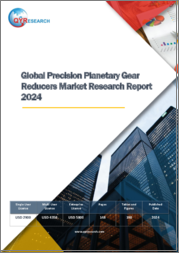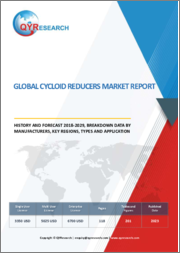
|
시장보고서
상품코드
1402023
세계의 수직축 헬리컬 기어 감속기 시장 예측(-2030년) : 제품 유형별, 용도별, 지역별 분석Perpendicular Axis Helical Gear Reducer Market Forecasts to 2030 - Global Analysis By Product Type, Application and by Geography |
||||||
Stratistics MRC에 따르면, 수직축 헬리컬 기어 감속기 세계 시장은 예측 기간 동안 CAGR 7.2%로 성장할 것으로 예상됩니다.
수직축 헬리컬 기어 감속기는 다양한 산업 환경에서 효과적인 동력 전달을 위해 정밀한 엔지니어링을 갖춘 기계 장치입니다. 이 기어 감속기는 입력 및 출력 샤프트의 수직 배열로 구별되며 기계의 토크와 속도를 조정할 수있는 작고 적응력이 뛰어난 방법을 제공합니다. 조용하고 부드러운 작동을 보장하는 헬리컬 기어의 설계는 기어 맞물림시 소음 수준을 줄입니다.
"유한 요소 모델" 섹션의 정적 유한 요소 모델에 따르면, 원래의 모든 강철 드릴 스트링과 3 개의 티타늄/강철 드릴 파이프 복합 드릴 스트링 계획에 대한 정적 분석이 수행되었습니다. 오리지널 스틸 드릴 스트링의 최대 축 인장력은 2020kN이고, 수원부에 위치한 S135 스틸 드릴 파이프의 인장 강도는 3311kN입니다.
산업 자동화의 발전
수직축 헬리컬 기어 감속기 산업은 지속적인 산업 자동화에 직면하여 성장하고 있습니다. 인더스트리 4.0의 로봇과 스마트 기술의 통합으로 인해 정밀한 제어 시스템이 요구됨에 따라 이러한 감속기는 필수 불가결한 요소가 되었습니다. 또한 다양한 자동화 공정에서 정확한 모션 제어, 토크 분배 및 속도 조절을 보장하는 능력은 완전히 통합된 지능형 제조 시스템으로 나아가는 과정에서 중요한 위치를 차지하고 있습니다.
악조건에 대한 대응에 한계가 있다
수직축 헬리컬 기어 감속기는 많은 응용 분야에서 우수한 성능을 발휘하지만, 가혹한 작동 조건에서는 그 성능을 발휘하지 못할 수 있습니다. 이러한 감속기의 수명과 성능은 고온, 부식성 물질에 대한 노출, 강한 진동과 같은 변수에 의해 영향을 받을 수 있습니다. 또한 열악한 환경에서 작업하는 산업에서는 더 탄력적인 대안을 고려해야 할 수도 있습니다.
재료 과학의 발전
감속기의 성능과 수명은 재료 과학의 지속적인 발전 덕분에 향상될 수 있습니다. 제조업체는 내마모성을 개선하고 마찰을 줄이며 가혹한 작동 조건을 견딜 수있는 새로운 재료와 코팅을 조사 할 수 있습니다. 또한 재료 혁신은 더 높은 효율과 더 긴 수명을 가진 기어 감속기를 만드는 데 도움이 될 수 있습니다.
기술의 급속한 노후화
기술이 빠르게 발전함에 따라 현재 감속기 모델은 곧 구식이 될 수 있습니다. 산업계는 곧 구식이 될 수있는 장비와 기술에 돈을 쓰는 것을 꺼릴 수 있습니다. 또한 경쟁력을 유지하기 위해 감속기 제조업체는 기술 발전에 대응하고 개선 된 솔루션을 제공하기 위해 지속적으로 기술 혁신을 계속해야 합니다.
COVID-19의 영향:
세계 공급망, 제조 운영 및 수요 역학의 혼란으로 인해 COVID-19 전염병은 수직축 헬리컬 감속기 시장에 큰 영향을 미쳤습니다. 첫 번째 단계에서는 폐쇄와 규제로 인해 산업 활동이 감소하고 물류가 어려워지고 생산이 중단되었습니다. 그러나 대유행 후반기에는 산업계가 새로운 정상 상태에 적응함에 따라 자동화 요구 사항이 증가하고 기어 감속기가 의료기기 및 물류 생산과 같은 중요한 응용 분야에서 기어 감속기가 중요한 부분이라는 인식으로 인해 천천히 회복되었습니다.
예측 기간 동안 이중 감속 헬리컬 기어 감속기 부문이 가장 큰 비중을 차지할 것으로 예상
이중 감속 헬리컬 기어 감속기 부문이 가장 큰 시장 점유율을 차지할 것으로 예상됩니다. 이 예측은 더 큰 토크 부하를 관리하고 눈에 띄는 감속을 제공하며 철강, 광업 및 대규모 제조와 같은 산업에서 중장비 애플리케이션을 충족시킬 수 있는 이 부문의 능력을 기반으로 합니다. 또한 이중 감속 설계는 효율성을 높일 뿐만 아니라 보다 균일한 부하 분산을 보장하기 때문에 안정적이고 견고한 동력 전달이 중요한 애플리케이션에 이상적입니다.
예측 기간 동안 가장 높은 CAGR을 보일 것으로 예상되는 항공우주 분야
항공우주 부문은 가장 높은 CAGR을 보이며 큰 성장을 보일 것으로 예상됩니다. 헬리컬 기어 감속기는 항공우주 산업의 정밀 엔지니어링에 대한 의존도가 높아지고 내구성이 뛰어나면서도 가벼운 기어 솔루션이 필요함에 따라 다양한 항공우주 응용 분야에서 중요한 역할을 하고 있습니다. 또한 헬리컬 기어 감속기에 대한 수요가 급증할 것으로 예상되며, 기술 발전으로 항공우주 산업이 더욱 정교하고 효율적인 기계로 발전함에 따라 이 부문은 크게 성장할 것으로 예상됩니다.
최대 점유율을 가진 지역
아시아태평양은 중국, 일본, 한국, 인도와 같은 국가의 급속한 산업화와 제조 활동으로 인해 수직축 헬리컬 감속기의 가장 큰 시장 점유율을 차지하고 있으며, 이 지역은 세계 시장에서 지배적 인 플레이어가되었습니다. 헬리컬 기어 감속기는 아시아태평양에서 발견되는 자동차, 기계 및 전자 산업에서 널리 사용됩니다. 또한, 이 지역의 소비자 기반 확대, 가처분 소득 증가, 도시화 진전은 모두 헬리컬 감속기 시장의 성장에 기여하고 있습니다.
CAGR이 가장 높은 지역:
북미 지역이 가장 높은 CAGR을 보이고 있습니다. 이 지역에서는 자동차, 항공우주, 산업 기계 등 헬리컬 기어 감속기의 주요 사용자 인 수많은 분야가 꾸준히 성장하고 있습니다. 이러한 분야는 고정밀하고 효과적인 기어 감속기가 필요하기 때문에 시장이 확대되고 있습니다. 또한 북미 지역의 헬리컬 기어 감속기 수요는 자동화 및 로봇 공학 채택과 같은 기술 발전으로 인해 더욱 자극을 받고 있습니다. 수직축 헬리컬 기어 감속기 시장의 강력한 성장은 이 지역이 기술 혁신, R&D에 집중하고 있으며, 기존 제조업체의 존재에 기인합니다.
무료 맞춤형 서비스
이 보고서를 구독하는 고객은 다음과 같은 무료 맞춤형 옵션 중 하나를 사용할 수 있습니다:
- 회사 프로필
- 추가 시장 기업의 종합적인 프로파일링(최대 3개사까지)
- 주요 기업 SWOT 분석(3개사까지)
- 지역 세분화
- 고객의 관심에 따른 주요 국가별 시장 추정 및 예측, CAGR(참고: 타당성 검토에 따른)
- 경쟁사 벤치마킹
- 제품 포트폴리오, 지리적 입지, 전략적 제휴를 기반으로 한 주요 기업 벤치마킹
목차
제1장 주요 요약
제2장 서문
- 개요
- 이해관계자
- 조사 범위
- 조사 방법
- 데이터 마이닝
- 데이터 분석
- 데이터 검증
- 조사 접근법
- 조사 소스
- 1차 조사 소스
- 2차 조사 소스
- 가정
제3장 시장 동향 분석
- 성장 촉진요인
- 성장 억제요인
- 기회
- 위협
- 제품 분석
- 용도 분석
- 신흥 시장
- 신종 코로나바이러스 감염증(COVID-19)의 영향
제4장 Porter's Five Forces 분석
- 공급 기업의 교섭력
- 구매자의 교섭력
- 대체품의 위협
- 신규 참여업체의 위협
- 경쟁 기업 간의 경쟁 관계
제5장 세계의 수직축 헬리컬 기어 감속기 시장 : 제품 유형별
- 헬리컬 기어 감속기
- 이중 감속 헬리컬 기어 감속기
- 평행축 헬리컬 감속기
- 기타 제품 유형
제6장 세계의 수직축 헬리컬 기어 감속기 시장 : 용도별
- 제조업
- 자동차
- 항공우주
- 에너지와 전력
- 기타 용도
제7장 세계의 수직축 헬리컬 기어 감속기 시장 : 지역별
- 북미
- 미국
- 캐나다
- 멕시코
- 유럽
- 독일
- 영국
- 이탈리아
- 프랑스
- 스페인
- 기타 유럽
- 아시아태평양
- 일본
- 중국
- 인도
- 호주
- 뉴질랜드
- 한국
- 기타 아시아태평양
- 남미
- 아르헨티나
- 브라질
- 칠레
- 기타 남미
- 중동 및 아프리카
- 사우디아라비아
- 아랍에미리트
- 카타르
- 남아프리카공화국
- 기타 중동 및 아프리카
제8장 주요 발전
- 계약, 파트너십, 협업, 합작투자
- 인수와 합병
- 신제품 발매
- 사업 확대
- 기타 주요 전략
제9장 기업 개요
- SEW-EURODRIVE
- Bonfiglioli
- Brevini Power Transmission
- Sumitomo Heavy Industries
- David Brown Santasalo
- NORD Drivesystems
- Elecon Engineering Company Limited
- Tandler
- Apex Dynamics
- ZF Friedrichshafen AG
According to Stratistics MRC, the Global Perpendicular Axis Helical Gear Reducer Market is growing at a CAGR of 7.2% during the forecast period. Perpendicular Axis Helical gear reducers are mechanical devices with precise engineering intended for effective power transmission in a range of industrial settings. These gear reducers, which are distinguished by their input and output shaft arrangements that are perpendicular, provide a small and adaptable way to regulate torque and speed in machinery. Noise levels are decreased during gear engagement thanks to the helical gear design, which guarantees quiet and smooth operation.
According to the static finite element model in "Finite element model" section, the static analysis was carried out on the original all-steel drill string and three titanium/steel drill pipe composite drill string plans. The maximum axial tensile force of the original steel drill string is 2020 kN and located at the wellhead, the tensile strength of the S135 steel drill pipe is 3311 kN.
Market Dynamics:
Driver:
Developments in industrial automation
The industry for helical gear reducers with perpendicular axes is growing in the face of continuous industrial automation. Precision control systems are required by Industry 4.0's integration of robotics and smart technologies, which makes these gear reducer's essential. Moreover, their capacity to guarantee precise motion control, distribution of torque, and regulation of speed in various automated processes places them in a crucial position as we move toward completely integrated and intelligent manufacturing systems.
Restraint:
Limited capability to handle adverse conditions
Perpendicular axis helical gear reducers are excellent in many applications, but in difficult operating conditions, they might not perform as well. The lifespan and performance of these gear reducers can be impacted by variables like high temperatures, exposure to corrosive materials, or strong vibrations. Additionally, it might be necessary for industries that work in harsh environments to look into more resilient alternatives.
Opportunity:
Developments in material science
The performance and longevity of gear reducers can be enhanced thanks to ongoing developments in material science. New materials and coatings that improve wear resistance, lower friction, and endure challenging operating conditions can be investigated by manufacturers. Furthermore, material innovations can aid in the creation of gear reducers with higher efficiency and longer lifespans.
Threat:
Rapid Obsolescence of Technology
Current gear reducer models may quickly become obsolete due to the rapid speed at which technology is developing. Industries might be reluctant to spend money on equipment and technology that could quickly become outdated. Moreover, to stay competitive, gear reducer manufacturers must constantly innovate to keep up with technological advancements and offer improved solutions.
COVID-19 Impact:
Due to disruptions in global supply chains, manufacturing operations, and demand dynamics, the COVID-19 pandemic had a major effect on the perpendicular axis helical gear reducer market. During the first stage, lockdowns and restrictions caused reduced industrial activities, logistical difficulties, and production halts. However, during the later stages of the pandemic, as industries adjusted to the new normal, there was a slow recovery propelled by a rise in automation requirements and the realization that gear reducers are vital parts of crucial applications, like the production of medical equipment and logistics.
The Double Reduction Helical Gear Reducers segment is expected to be the largest during the forecast period
It is projected that the double reduction helical gear reducers segment will hold the largest market share. This expectation is based on the segment's capacity to manage greater torque loads, offer notable reductions in speed, and serve heavy-duty applications in steel, mining, and large-scale manufacturing, among other industries. Moreover, the double reduction design is ideal for applications where dependable and sturdy power transmission is crucial because it not only increases efficiency but also guarantees a more even distribution of load.
The Aerospace segment is expected to have the highest CAGR during the forecast period
With the highest CAGR, the aerospace segment is expected to experience significant growth. Helical gear reducers play a crucial role in a range of aerospace applications due to the aerospace industry's growing dependence on precision engineering and the need for durable yet lightweight gear solutions. Additionally, helical gear reducer demand is predicted to soar, leading to significant growth for this segment as technological advancements push the aerospace industry toward more advanced and efficient machinery.
Region with largest share:
Asia-Pacific holds the largest market share for perpendicular-axis helical gear reducer, due to the rapid industrialization and manufacturing activities in nations like China, Japan, South Korea, and India, this region has become a dominant player in the global market. Helical gear reducers are widely used by the automotive, machinery, and electronics industries found in the Asia-Pacific region. Furthermore, the region's expanding consumer base, growing disposable incomes, and growing urbanization have all contributed to the market's growth for helical gear reducers.
Region with highest CAGR:
The North America has the highest CAGR. Numerous sectors, such as automotive, aerospace, and industrial machinery-which are major users of helical gear reducers-have been steadily expand in this region. The market is expanding due to the need for highly accurate and effective gear reducers in these sectors. Furthermore, the need for helical gear reducers in North America has been further stimulated by technological advancements like the adoption of automation and robotics. Strong growth in the perpendicular axis helical gear reducer market has been attributed to the region's concentration on innovation, research, and development and the presence of established manufacturers.
Key players in the market:
Some of the key players in Perpendicular Axis Helical Gear Reducer market include SEW-EURODRIVE, Bonfiglioli, Brevini Power Transmission, Sumitomo Heavy Industries, David Brown Santasalo, NORD Drivesystems, Elecon Engineering Company Limited , Tandler, Apex Dynamics and ZF Friedrichshafen AG.
Key Developments:
In November 2023, Elecon Engineering Company Limited's shares were up 1.85 per cent after the company bagged a contract worth ₹51.41 crores from ArcelorMittal Nippon Steel India Limited (AMNS). This contract encompasses the supply and supervision of a Pipe Conveyor System to be deployed at AMNS's Hazira Plant located in Gujarat, India.
In August 2023, Apex Dynamics has expanded into hypoid gearboxes with its BKM Series of high precision hypoid gearboxes which offer high torque, superior accuracy, excellent radial load capacity and low backlash in a design compatible with any motor. Hypoid gearboxes are a type of spiral bevel gearbox. In contrast to traditional bevel gearboxes, they have non-intersecting axes, meaning they are not parallel, but rather are offset from one another. This provides them with hyperbolic rather than conical geometry.
In January 2023, Japan's Sumitomo Heavy Industries, the majority owner of Link-Belt Cranes and HSC Cranes, has concluded its agreement with Hitachi Construction Machinery to acquire its 34 percent stake in Sumitomo Heavy Industries Construction Cranes/ HSC, thus converting it into a wholly owned Sumitomo subsidiary. The deal was originally agreed at the end of November.
Product Types Covered:
- Helical Gear Reducers
- Double Reduction Helical Gear Reducers
- Parallel Shaft Helical Gear Reducers
- Other Product Types
Applications Covered:
- Manufacturing
- Automotive
- Aerospace
- Energy and Power
- Other Applications
Regions Covered:
- North America
- US
- Canada
- Mexico
- Europe
- Germany
- UK
- Italy
- France
- Spain
- Rest of Europe
- Asia Pacific
- Japan
- China
- India
- Australia
- New Zealand
- South Korea
- Rest of Asia Pacific
- South America
- Argentina
- Brazil
- Chile
- Rest of South America
- Middle East & Africa
- Saudi Arabia
- UAE
- Qatar
- South Africa
- Rest of Middle East & Africa
What our report offers:
- Market share assessments for the regional and country-level segments
- Strategic recommendations for the new entrants
- Covers Market data for the years 2021, 2022, 2023, 2026, and 2030
- Market Trends (Drivers, Constraints, Opportunities, Threats, Challenges, Investment Opportunities, and recommendations)
- Strategic recommendations in key business segments based on the market estimations
- Competitive landscaping mapping the key common trends
- Company profiling with detailed strategies, financials, and recent developments
- Supply chain trends mapping the latest technological advancements
Free Customization Offerings:
All the customers of this report will be entitled to receive one of the following free customization options:
- Company Profiling
- Comprehensive profiling of additional market players (up to 3)
- SWOT Analysis of key players (up to 3)
- Regional Segmentation
- Market estimations, Forecasts and CAGR of any prominent country as per the client's interest (Note: Depends on feasibility check)
- Competitive Benchmarking
- Benchmarking of key players based on product portfolio, geographical presence, and strategic alliances
Table of Contents
1 Executive Summary
2 Preface
- 2.1 Abstract
- 2.2 Stake Holders
- 2.3 Research Scope
- 2.4 Research Methodology
- 2.4.1 Data Mining
- 2.4.2 Data Analysis
- 2.4.3 Data Validation
- 2.4.4 Research Approach
- 2.5 Research Sources
- 2.5.1 Primary Research Sources
- 2.5.2 Secondary Research Sources
- 2.5.3 Assumptions
3 Market Trend Analysis
- 3.1 Introduction
- 3.2 Drivers
- 3.3 Restraints
- 3.4 Opportunities
- 3.5 Threats
- 3.6 Product Analysis
- 3.7 Application Analysis
- 3.8 Emerging Markets
- 3.9 Impact of Covid-19
4 Porters Five Force Analysis
- 4.1 Bargaining power of suppliers
- 4.2 Bargaining power of buyers
- 4.3 Threat of substitutes
- 4.4 Threat of new entrants
- 4.5 Competitive rivalry
5 Global Perpendicular Axis Helical Gear Reducer Market, By Product Type
- 5.1 Introduction
- 5.2 Helical Gear Reducers
- 5.3 Double Reduction Helical Gear Reducers
- 5.4 Parallel Shaft Helical Gear Reducers
- 5.5 Other Product Types
6 Global Perpendicular Axis Helical Gear Reducer Market, By Application
- 6.1 Introduction
- 6.2 Manufacturing
- 6.3 Automotive
- 6.4 Aerospace
- 6.5 Energy and Power
- 6.6 Other Applications
7 Global Perpendicular Axis Helical Gear Reducer Market, By Geography
- 7.1 Introduction
- 7.2 North America
- 7.2.1 US
- 7.2.2 Canada
- 7.2.3 Mexico
- 7.3 Europe
- 7.3.1 Germany
- 7.3.2 UK
- 7.3.3 Italy
- 7.3.4 France
- 7.3.5 Spain
- 7.3.6 Rest of Europe
- 7.4 Asia Pacific
- 7.4.1 Japan
- 7.4.2 China
- 7.4.3 India
- 7.4.4 Australia
- 7.4.5 New Zealand
- 7.4.6 South Korea
- 7.4.7 Rest of Asia Pacific
- 7.5 South America
- 7.5.1 Argentina
- 7.5.2 Brazil
- 7.5.3 Chile
- 7.5.4 Rest of South America
- 7.6 Middle East & Africa
- 7.6.1 Saudi Arabia
- 7.6.2 UAE
- 7.6.3 Qatar
- 7.6.4 South Africa
- 7.6.5 Rest of Middle East & Africa
8 Key Developments
- 8.1 Agreements, Partnerships, Collaborations and Joint Ventures
- 8.2 Acquisitions & Mergers
- 8.3 New Product Launch
- 8.4 Expansions
- 8.5 Other Key Strategies
9 Company Profiling
- 9.1 SEW-EURODRIVE
- 9.2 Bonfiglioli
- 9.3 Brevini Power Transmission
- 9.4 Sumitomo Heavy Industries
- 9.5 David Brown Santasalo
- 9.6 NORD Drivesystems
- 9.7 Elecon Engineering Company Limited
- 9.8 Tandler
- 9.9 Apex Dynamics
- 9.10 ZF Friedrichshafen AG














